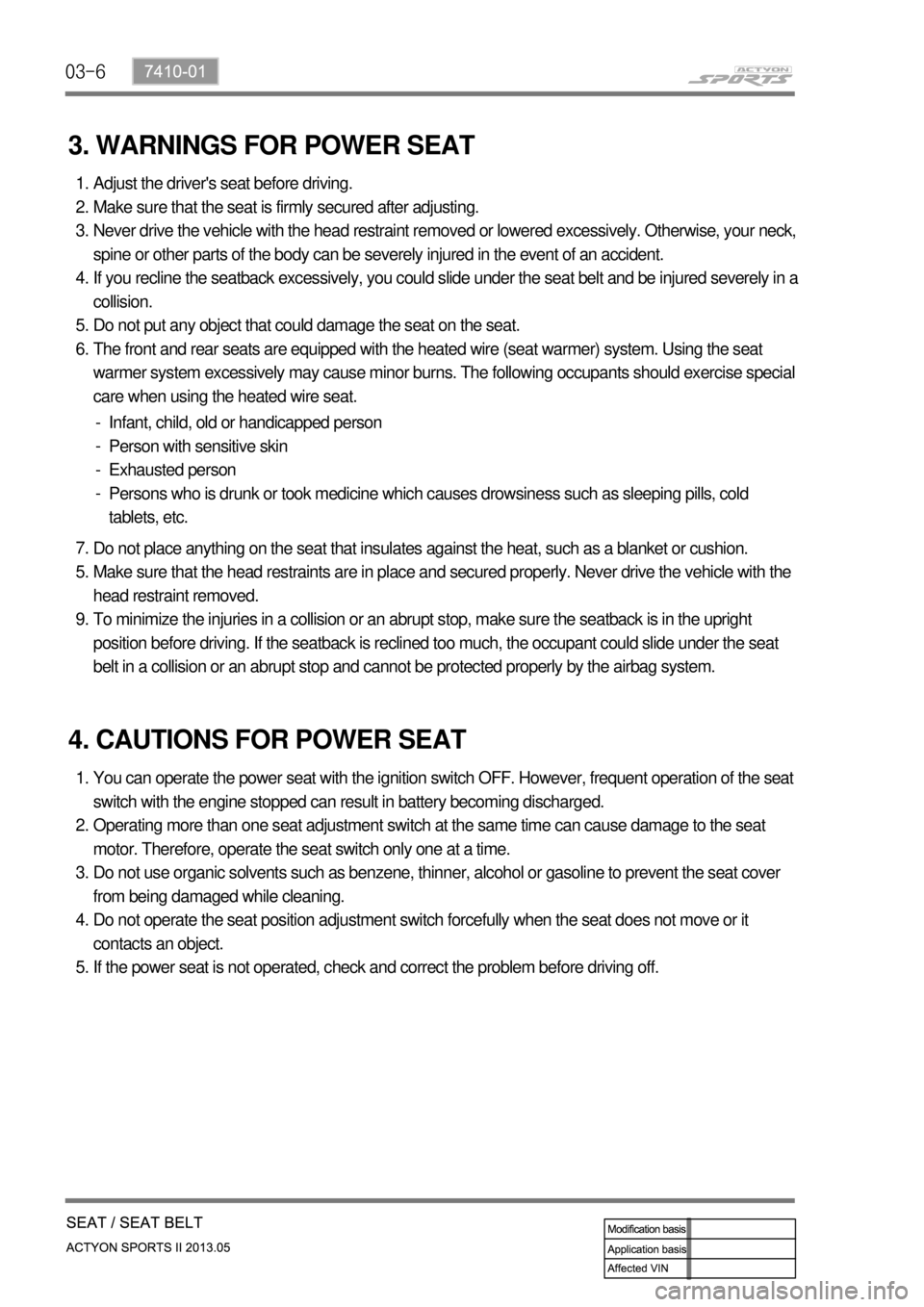Page 703 of 751
01-24
5. A/C INPUT/OUTPUT DIAGRAM
Below diagram shows the input/output mapping between the components of FATC A/C and A/C
controller briefly.
▶ A/C compressor control by engine ECU
In case of current vehicle models, the system turns ON or OFF the compressor switch according to the
refrigerant pressure, ambient temperature and condenser temperature to protect the A/C circuits.
However, for the vehicles equipped with DI engine, the engine ECU turns off the A/C compressor unde
r
below conditions, including those above.
Coolant temperature: 20℃ or less
Coolant temperature: 115℃ or more
For approx. 4 sec. after starting the engine
Engine speed: 650 rpm or less
Engine speed: 4,500 rpm or more
During abrupt acceleration for the vehicle equipped with manual transmission 1.
2.
3.
4.
5.
6.
Page 723 of 751

02-14
4. DEPLOYMENT
According to the collision deceleration rate that each collision G sensor reads, the air bag unit sends out
about 2~4 or higher Amp current. This current generates some heat, which fires the detonator in the
inflator.
The table shows the basic inner resistance of the air bag related module and the basic instant current
necessary for firing.
1) Air Bag System Deployment (Firing Loop)
2) Air Bag Deployment Signal Output (Crash Out)
When the air bag deploys, the signal is sent to STICS to perform the basic security operation which is
the automatic door unlock function that release the automatic door lock mode.
Deployment signal
output (crash out)200ms
Automatic Door Unlock (Crash unlock: unlock when colliding) ▶
The air bag collision signal input cannot be accepted within 7 seconds after turning the ignition key to
"ON" position.
After this period, the door lock system outputs "UNLOCK" for all doors for 5 seconds from 40 ms after
receiving the air bag collision signal.
Even though the key is turned to "OFF" position during the output of "UNLOCK", the output continues
on for remaining period.
The function is erased when turning "OFF" the ignition switch. 1.
2.
3.
4.
Air bag module
DAB /PABSeat belt pretensioner(BPA)
Resistance (at -30 ~ 85˚C) 2 ±0.3 Ω 2.15 ±0.35 Ω
Firing current 1.2 Amps 0.8 Amps
Please do not connect a tester to any air bag connector or single item to measure the supplied
power or resistance. The detonator may explode due to a sudden extra power supplied by the
tester.
Before removing or installing any air bag related components, disconnect the negative battery
cable. -
-
Page 730 of 751

03-6
3. WARNINGS FOR POWER SEAT
Adjust the driver's seat before driving.
Make sure that the seat is firmly secured after adjusting.
Never drive the vehicle with the head restraint removed or lowered excessively. Otherwise, your neck,
spine or other parts of the body can be severely injured in the event of an accident.
If you recline the seatback excessively, you could slide under the seat belt and be injured severely in a
collision.
Do not put any object that could damage the seat on the seat.
The front and rear seats are equipped with the heated wire (seat warmer) system. Using the seat
warmer system excessively may cause minor burns. The following occupants should exercise special
care when using the heated wire seat. 1.
2.
3.
4.
5.
6.
Infant, child, old or handicapped person
Person with sensitive skin
Exhausted person
Persons who is drunk or took medicine which causes drowsiness such as sleeping pills, cold
tablets, etc. -
-
-
-
Do not place anything on the seat that insulates against the heat, such as a blanket or cushion.
Make sure that the head restraints are in place and secured properly. Never drive the vehicle with the
head restraint removed.
To minimize the injuries in a collision or an abrupt stop, make sure the seatback is in the upright
position before driving. If the seatback is reclined too much, the occupant could slide under the seat
belt in a collision or an abrupt stop and cannot be protected properly by the airbag system. 7.
5.
9.
4. CAUTIONS FOR POWER SEAT
You can operate the power seat with the ignition switch OFF. However, frequent operation of the seat
switch with the engine stopped can result in battery becoming discharged.
Operating more than one seat adjustment switch at the same time can cause damage to the seat
motor. Therefore, operate the seat switch only one at a time.
Do not use organic solvents such as benzene, thinner, alcohol or gasoline to prevent the seat cover
from being damaged while cleaning.
Do not operate the seat position adjustment switch forcefully when the seat does not move or it
contacts an object.
If the power seat is not operated, check and correct the problem before driving off. 1.
2.
3.
4.
5.
Page 737 of 751
03-137410-01
Seat belt reminder
2) Seat Belt Reminder & Pretensioner
In addition to securing the occupants to the seat, the seat belt has the seat belt reminder and the
pretensioner which retracts the seat belts while the air bags are deployed and the load limiter which
protects the seat belt from being retracted excessively.
Driver's seat belt reminder ▶
The STICS detects if the seat belt is fastened or not using a signal from the driver's seat belt switch. The
seat belt reminder flashes and the chime sounds when the seat belt is not fastened.
The seat belt reminder stops its operation as soon as the seat belt is fastened.
Chime
Pretensioner ▶
It is installed on the driver and passenger LH/RH B-pillar and the pretensioner is installed in it, which
retracts the seat belt when the air bag is deployed in case of the front impact to secure the occupant to
the seat.
Anchor
Pretensioner